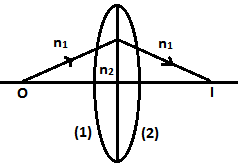Lens Maker’s Formula
Lens is a transparent medium bounded by two surfaces, at least one of them must be curved. A relation between the focal length of a lens, radii of curvature of two surfaces and the refractive index of the material is called lens maker’s formula.
Lens Maker’s Formula: Consider the thin lens shown here with the two refracting surfaces having radii of curvature equal to R₁ and R₂ respectively. The refractive indices of this surrounding medium and of the material of the lens are n₁ and n₂ respectively. Now using the result that we obtained for refraction at single spherical surface we get,

For First Case: \(\frac{{{n}_{2}}}{{{v}_{1}}}\,-\,\frac{{{n}_{1}}}{u}\,=\,\frac{{{n}_{2}}-{{n}_{1}}}{{{R}_{1}}}\) … (1)
For Second case: \(\frac{{{n}_{1}}}{v}\,-\,\frac{{{n}_{2}}}{{{v}_{1}}}\,=\,\frac{{{n}_{1}}\,-\,{{n}_{2}}}{{{R}_{2}}}\) … (2)
Adding equations (1) and (2), we get:
\(\frac{{{n}_{1}}}{v}\,\,-\,\,\frac{{{n}_{1}}}{u}\,\,=\,\,({{n}_{2}}\,\,-\,\,{{n}_{1}})\left[ \frac{1}{{{R}_{1}}}\,\,-\,\,\frac{1}{{{R}_{2}}} \right]\).
\(\frac{1}{v}\,\,-\,\,\frac{1}{u}\,\,=\,\,\left( {{n}_{2}}\,\,-\,\,{{n}_{1}} \right)\left[ \frac{1}{{{R}_{1}}}\,\,-\,\,\frac{1}{{{R}_{2}}} \right]\).
When, u = ∞, v = f
\(\frac{1}{f}\,\,=\,\,\left[ \frac{{{n}_{2}}}{{{n}_{1}}}\,\,-\,\,1 \right]\left[ \frac{1}{{{R}_{1}}}\,\,-\,\,\frac{1}{{{R}_{2}}} \right]\).
\(\frac{1}{v}\,\,-\,\,\frac{1}{u}\,\,=\,\,\frac{1}{f}\).
A lens is converting if its focal length is positive and diverging if focal length is negative, from this we can conclude that a convex lens need not necessarily be a converging and a concave lens diverging.
Lens maker’s formula limitations:
- The lens needs to be thin. This is because the separation between the two refracting surface will also be small.
- The medium on either side of the lens needs to be the same.
